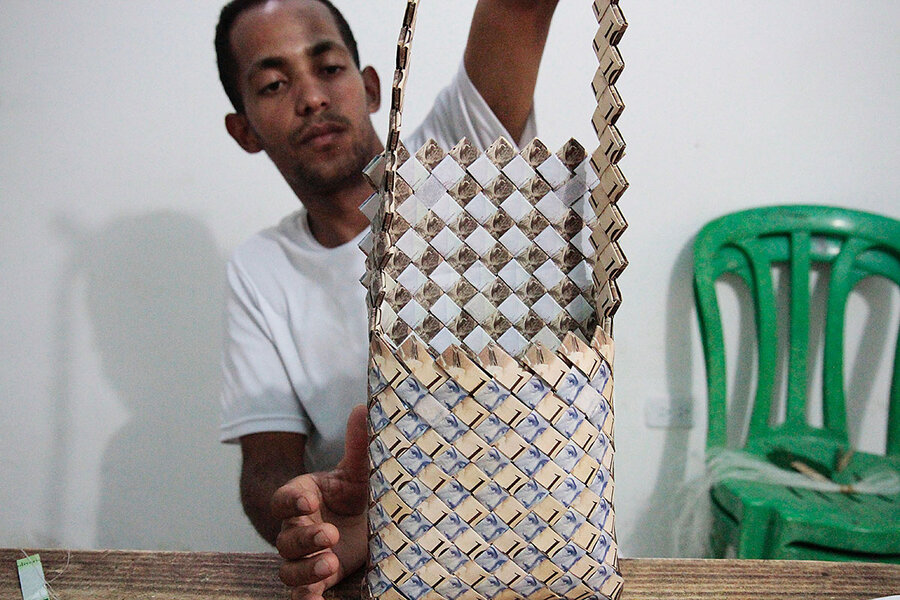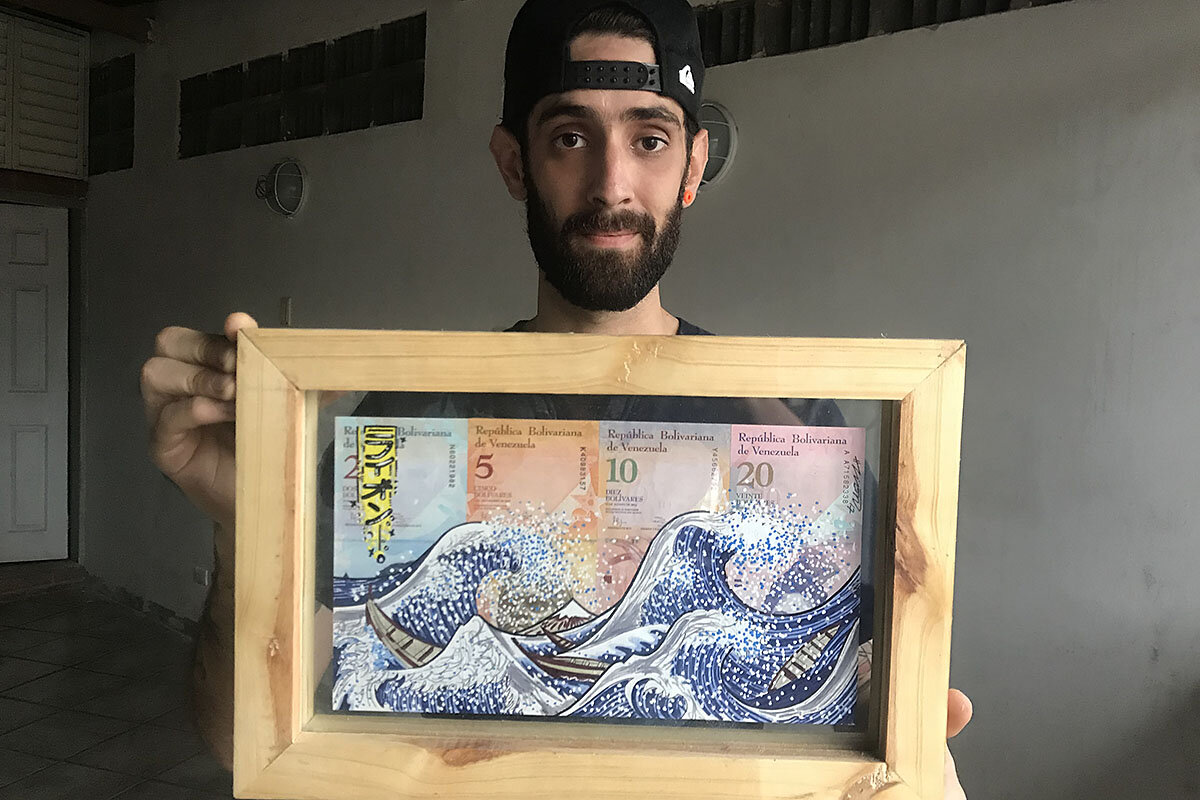As inflation devastates Venezuela, artists make purses and paintings out of bills
Loading...
| CÚCUTA, COLOMBIA
Inflation has been a challenge in Venezuela for years, but over the past 12 months the bolívar has become more valuable as an art and craft material than as something in the bank. Just look at Jesús Campos, who can sell a purse crafted out of hundreds of folded bolívar bills for about $10 – when the notes alone wouldn’t have been enough for a cup of coffee. Another artist in Venezuela is using the currency as his canvas and selling his painted bolívares online. The government has acknowledged money isn’t stretching as far anymore, but President Nicolás Maduro places the blame on “mafias” trying to take down Venezuela’s socialist movement. He’s vowed to slash some of the zeros off prices – and wages – by June. Few economists see that as an effective solution. “We might be able to count prices easier,” says one Caracas-based economist of the government’s plans. “But if inflation continues at the same rate, those new bills will soon become useless.”
Why We Wrote This
Economic crises like Venezuela's upturn lives, but that doesn't mean creativity disappears. Some Venezuelan artists are making a point – and art – out of the country's now near-worthless currency.
In a windowless apartment on the outskirts of this Colombian border town, Jesús Campos puts the final stitches on his latest creation: A violet and khaki handbag made exclusively from Venezuela’s rapidly depreciating currency.
The bag is made with 800 Venezuelan bolívar bills that have been carefully folded in rectangles and woven together in a geometric pattern. They are so tightly packed that water can’t get through, and the bag feels similar to fake leather.
In Venezuela, the bolívar bills used to make this purse wouldn’t be enough to purchase a coffee, says Mr. Campos. In Colombia, he can fetch around $10 for the handbag – enough to buy two pounds of chicken and three pounds of rice.
Why We Wrote This
Economic crises like Venezuela's upturn lives, but that doesn't mean creativity disappears. Some Venezuelan artists are making a point – and art – out of the country's now near-worthless currency.
“I never thought our currency would be so useless that I’d be working with it” as a material, says the young artisan. He moved across the border to Colombia with his wife and children earlier this year in search of a more stable life.
“Now the only way you can give bolívares value is by turning them into art,” he says.
Campos’ handmade bolívar accessories – he also makes wallets and belts – are a shining example of the resourcefulness of some Venezuelans, desperate to make ends meet. But they’re also a dramatic indicator of just how steep inflation is – and how worthless the country’s currency has become.
Economists in Venezuela and the US estimate that over the past 12 months, the inflation rate has soared to more than 16,000 percent, with prices for some goods doubling every 18 days.
A carton of 30 eggs, which cost 5,000 bolívares at the beginning of last year, now sells for approximately 2 million. A pound of chicken will set you back more than 1 million bolívares in Venezuela, or about 40 percent of the current monthly minimum wage.
This type of hyperinflation makes Venezuela’s currency a problem for merchants: It requires bags full of 100 or even 1,000 bolívar bills to pay for simple household items.
“Sometimes I buy the bills up from people who can’t use them anymore,” Campos says. “But sometimes Venezuelans who are coming into Colombia see my work, appreciate it and give me a bunch of bills for free.”
José Luis León, a graphic designer in the Venezuelan city of San Cristóbal, draws Japanese comic-book characters, scenes from Star Wars movies, and images depicting Venezuela’s most emblematic tourist attractions on bolívar notes of all sizes, including the recently issued 20,000 bill.
Mr. León then posts pictures on Instagram with a hashtag that translates to “Devalued Venezuela.”
“If I give you one of these bills, you will go out there and do nothing with it,” León says in his studio, where he spends long nights working on his drawings. He frames finished products in wood and glass cases.
“When I get a bill and turn it into art … it tells you the story of what this country is going through,” he says.
León has received international recognition for his work, selling pieces to Venezuelans living in the United States, Colombia, and as far away as Switzerland. The work sells for anywhere from US$2 to $100.
The bills are transformed into pop art, political protest, or simply souvenirs for Venezuelans who have left the country. It all depends on how he decorates them with his markers and paint.
“Having one of these bills is like having a little piece of our country with you,” León says.
Printing to plug the deficit
Venezuela’s inflation stems from years of economic mismanagement, says Antonio Ecarri, director of the Arturo Uslar Pietri think tank in Caracas. Former President Hugo Chávez, who rode a wave of sky-high oil prices during most of his time in office, spent heavily on social programs in and outside the country, but did little to build up the nation’s coffers.
Nicolás Maduro, Chavez’s handpicked successor, inherited the same spending patterns, but within two years of his presidency, the price of oil dropped by half.
As a result, Venezuela has turned to printing more money to keep up with government expenditures and plug a growing deficit, Mr. Ecarri says.
Venezuela’s total money supply rose by 5,000 percent over the past 12 months, says Caracas-based economist Asdrúbal Oliveros, fueling inflation to levels that have become so “crazy” that many businesses now conduct transactions in euros and US dollars.
Some see a solution in this, with analysts like Ecarri suggesting Venezuela adopt the US dollar as its official currency. The strategy has worked for several developing countries dealing with high inflation, from Ecuador to Montenegro.
It takes “away this possibility of politicians going to the central bank and telling it to turn on the press,” says Steve Hanke, a professor of applied economics at John Hopkins University, who helped Ecuador to dollarize in 2001.
But some say dollarizing an economy that’s heavily dependent on oil exports is not the best solution.
Mr. Olivares says that if Venezuela stops printing its own money, it would not be able to use monetary policy to increase imports or boost domestic consumption. That would make the country vulnerable if oil prices fell.
“Dollarization isn’t the only way to stop inflation,” Olivares says. “Other countries have done it with serious adjustments, that include putting public spending under control.”
But as President Maduro heads into elections on May 20 – a vote that’s been decried by governments around the region as undemocratic – his focus on solutions lies elsewhere. Maduro blames “mafias” trying to overthrow his government with destabilizing the economy.
He’s ordered the inspection of thousands of supermarkets and promised to nationalize stores that increase prices “like crazy.”
In March, Maduro announced that the government will strike three zeros off all prices – and wages – by next month. He also said the central bank will issue a new set of bolívares that will have fewer zeros on them.
“We might be able to count prices easier,” says Oliveros of the government’s announced plans. “But if inflation continues at the same rate, those new bills will soon become useless.”
It would give artisans like Campos and León more raw material to work with, though.
“My plan now is to make a shirt and some pants out of bolívares, and go to tourist areas to sell my purses,” Campos says of his future business plans. “The only way we will stop doing this is if the bolívar regains its value.”








